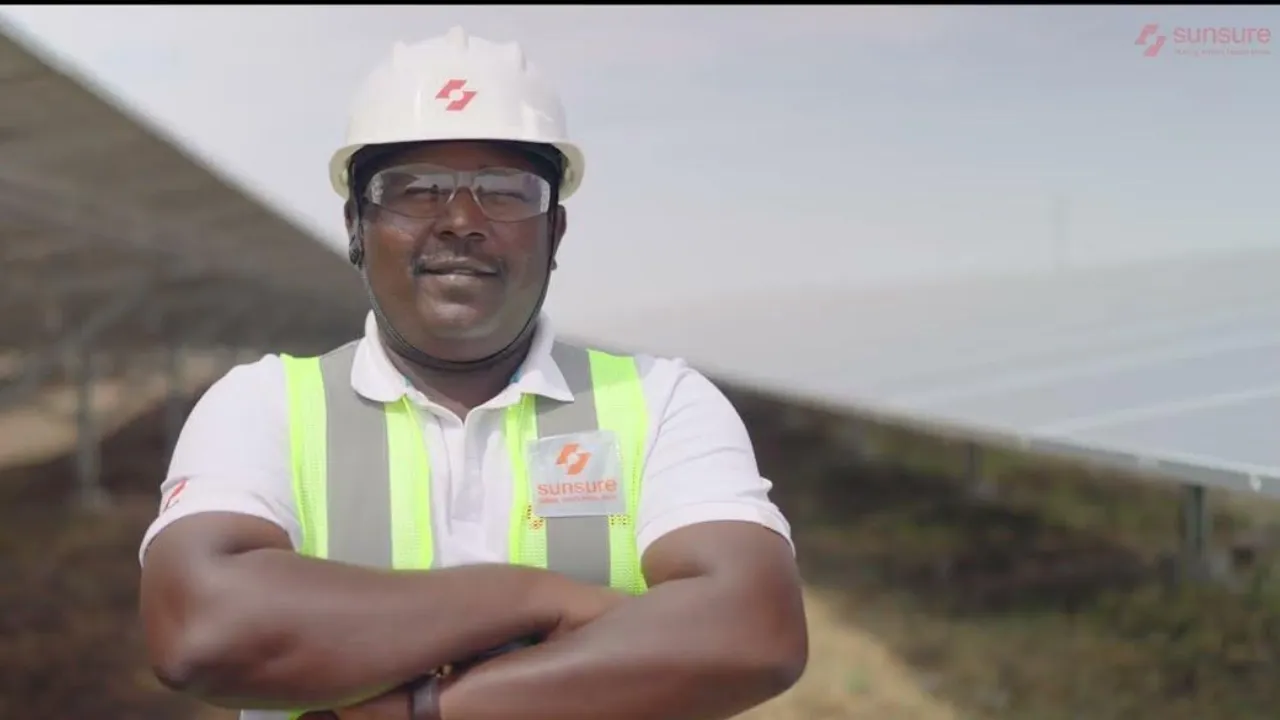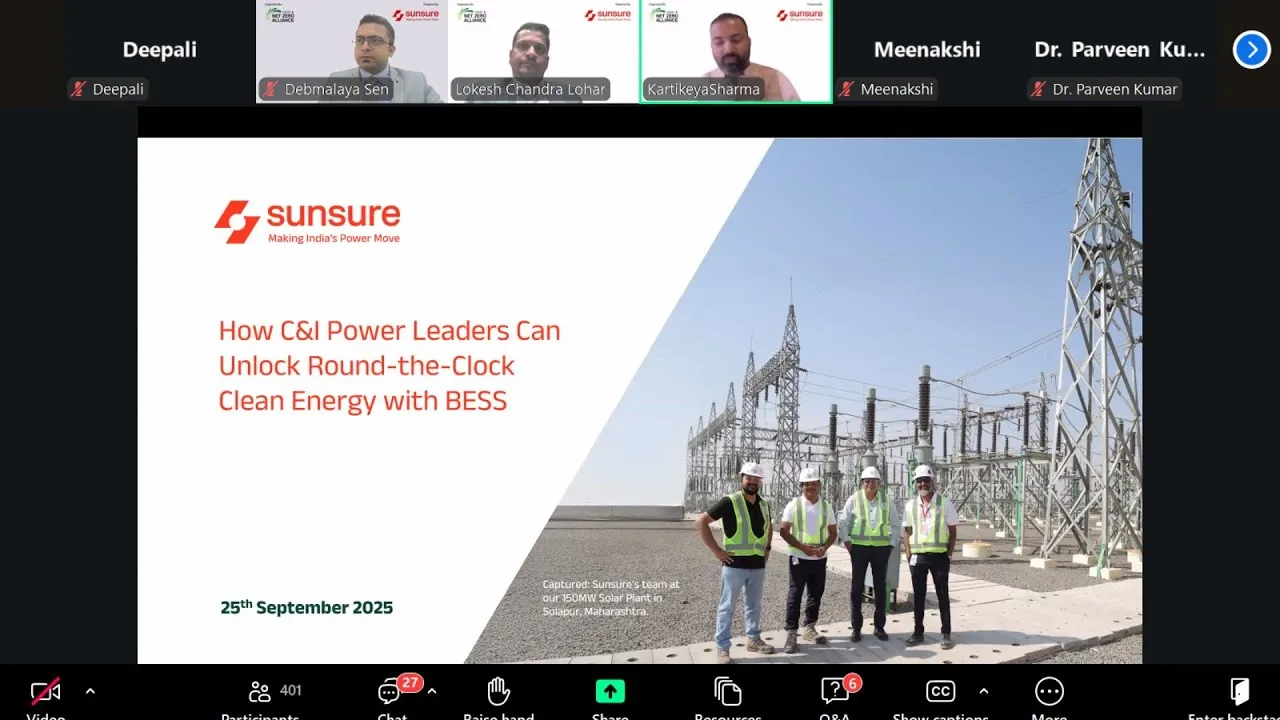In 2024, global CO2 equivalent emissions reached a staggering 57.4 Gigatons, and temperatures exceeded the critical 1.5°C limit for nearly 90 days. The planet has started to witness the detrimental effects of climate change in the form of heatwaves, droughts, unpredictable precipitation and more. Slowly over the decades, the concern of climate change has turned into a significant threat to the environment and humans.
To solve this problem, every country, including India, is focusing on increasing the use of carbon-free energy (CFE) or clean energy. India’s target is to reach 500 GW of installed capacity of non-fossil fuel-based energy by 2030. Solar and wind energy have so far been the largest contributors to this journey.
However, Solar power depends on sunlight throughout the day and weather conditions. Similarly, wind energy depends on wind speed and patterns. This creates a mismatch between energy supply and demand.
Is there any solution? Can we really reach the net zero target by 2070? The answer is RTC power. Today in this blog, you will learn about how round-the-clock renewable energy can fulfil the dream of India’s 24/7 clean power ambition and goals.
What is round the clock (RTC) Power?
The full form of RTC Power is Round-The-Clock Power which means continuous electricity supply 24 hours a day, 7 days a week.
The RTC model uses a combination of various renewable energy sources, such as solar and wind, and combined energy storage systems like grid-scale batteries or pumped hydro storage systems to maintain a stable supply.
RTC power supply is essential for maintaining grid stability and managing energy demand, scheduling and supply properly. The Indian government has implemented RTC tenders to implement the Round the Clock Power Supply from renewable energy sources.
Don’t know about RTC Tenders? Read the following section.
RTC Tender Models in India
RTC tenders are power purchase agreements (PPAs) which require selected power generators to supply a specified amount of electricity continuously, 24/7, throughout the year to the off-takers, which are utility companies releasing the tenders. These tenders help in driving the market towards RTC power solutions boosting India’s Energy security and pushing developers to innovate and create true firm and dispatchable renewable energy systems.
The Indian government actively encourages RTC tenders to enhance the share of RE in the power generation mix and support sustainable energy transition efforts in the country.
Follow the table below to learn about India’s First two RTC tender models and their detailed information.
| Aspects |
RTC-1 |
RTC-2 |
| Technology Mix |
Leveraging
RE + ESS |
80% RE
20% Other |
51% RE
49% Thermal |
| Capacity Utilisation |
80%
|
85% |
85% |
| (Solar: Wind) |
30:70 |
40:60 |
30:70 |
| RE capacity oversize % |
225% |
250% |
~50% |
| Surplus generation |
25-30% |
30-35% |
Very low |
| BESS component |
100 MWh |
Not included |
Not included |
Note- RE = Renewable Energy, ESS = Energy Storage Systems.
Current scenario and future goals of India For clean power generation
Before we start how round-the-clock renewable energy can support India’s clear power dream, let’s have a quick look at the current scenario and future goals of clean power in India.
- Current Scenario of India’s Renewable Energy Revolution
This is the achievements of India’s renewable energy at the end of 2024:
| Parameter |
Details |
| Total Non-Fossil Fuel Capacity |
217.62 GW as of January 20, 2025 |
| Solar Capacity Added (2024) |
24.5 GW (Utility: 18.5 GW, Rooftop: 4.59 GW, Off-grid: 1.48 GW) |
| Wind Capacity Added (2024) |
3.4 GW |
| Top States – Utility Solar |
Rajasthan, Gujarat, Tamil Nadu (71% share) |
| Top States – Wind |
Gujarat (1,250 MW), Karnataka (1,135 MW), Tamil Nadu (980 MW) |
| Growth in Rooftop Solar (2024) |
53% Increase (Total: 4.59 GW Installed) |
| Off-Grid Solar Growth (2024) |
182% Increase (Total: 1.48 GW Installed) |
| Key Policy – Rooftop Solar |
PM Surya Ghar: Muft Bijli Yojana (7 lakh installations) |
| Cumulative disclosed clean PPA volume
|
6,608 MW (India has the largest and most developed clean PPA market) |
India has experienced the largest absolute growth in renewable electricity generation among these markets over the last 12 years.
Source- PIB Delhi (2024 Achievements & 2025 Roadmap), Bloomberg NEF 24/7 Carbon-Free Energy Procurement in APAC: Pathways for Companies and Countries, November 26, 2024.
- Future Goals & Projections
India’s future goals and ambitions with renewable energy are as follows:
1. India is focusing on reducing emission intensity (GDP-based) by 45% by 2030 relative to the 2005 level.
2. 50% of power capacity from non-fossil fuel sources by 2030.
3. Net Zero target by 2070.
According to Bloomberg NEF 24/7 Carbon-Free Energy Procurement in APAC: Pathways for Companies and Countries, here are some important goals India can hit in 2050 – Net Zero Scenario.
-> In this scenario, renewable energy may take 81% of India’s electricity market share where utility-scale solar will be the top electricity supplier.
-> By that time, the Technology share of installed capacity in India’s renewable energy sector will be:
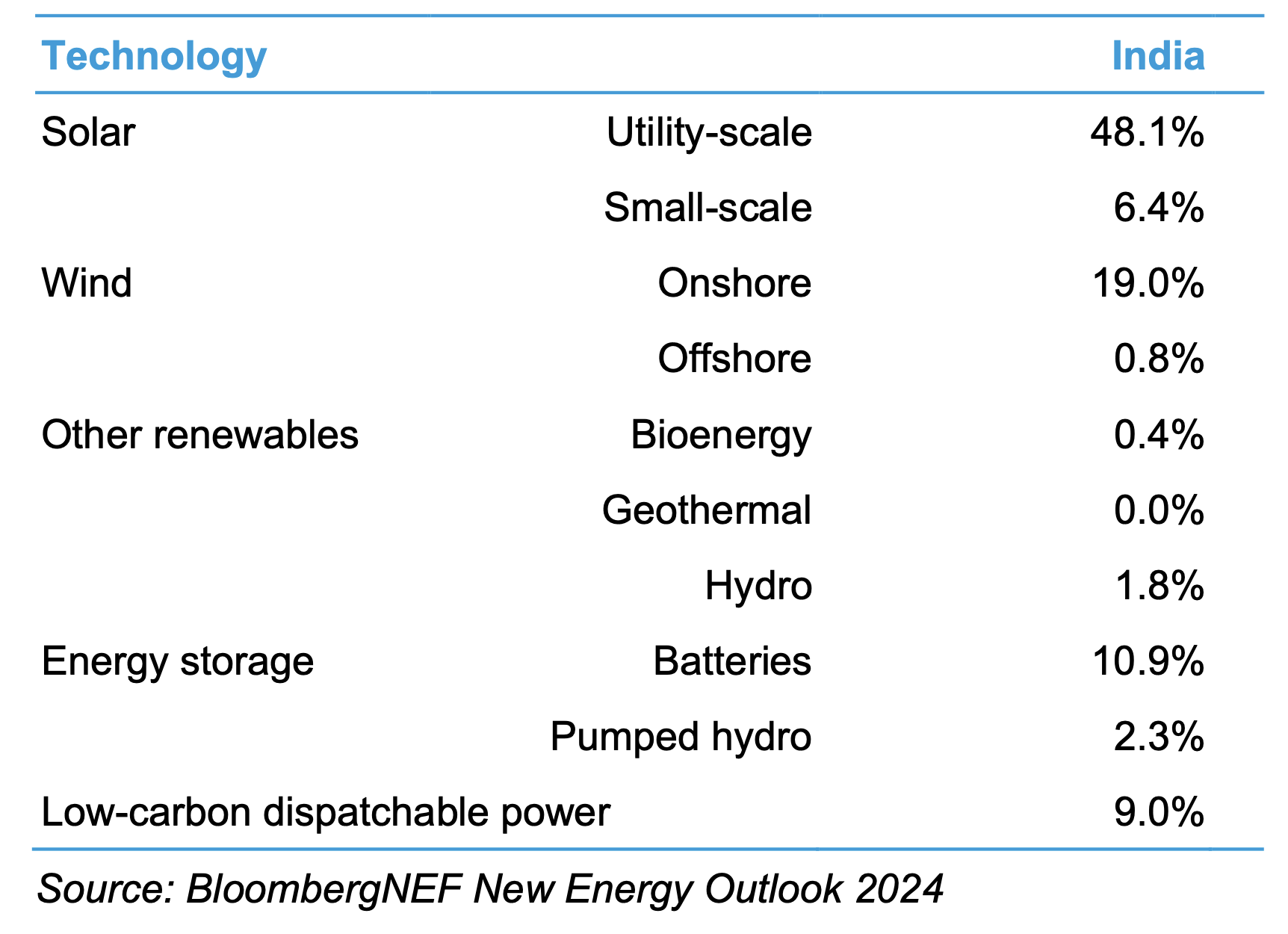
Installed capacity in India’s renewable energy
-> By that time, the technology share of annual generation in India’s renewable energy sector will be:

-> In the Net Zero Scenario, India’s annual electricity generation by technology will be:
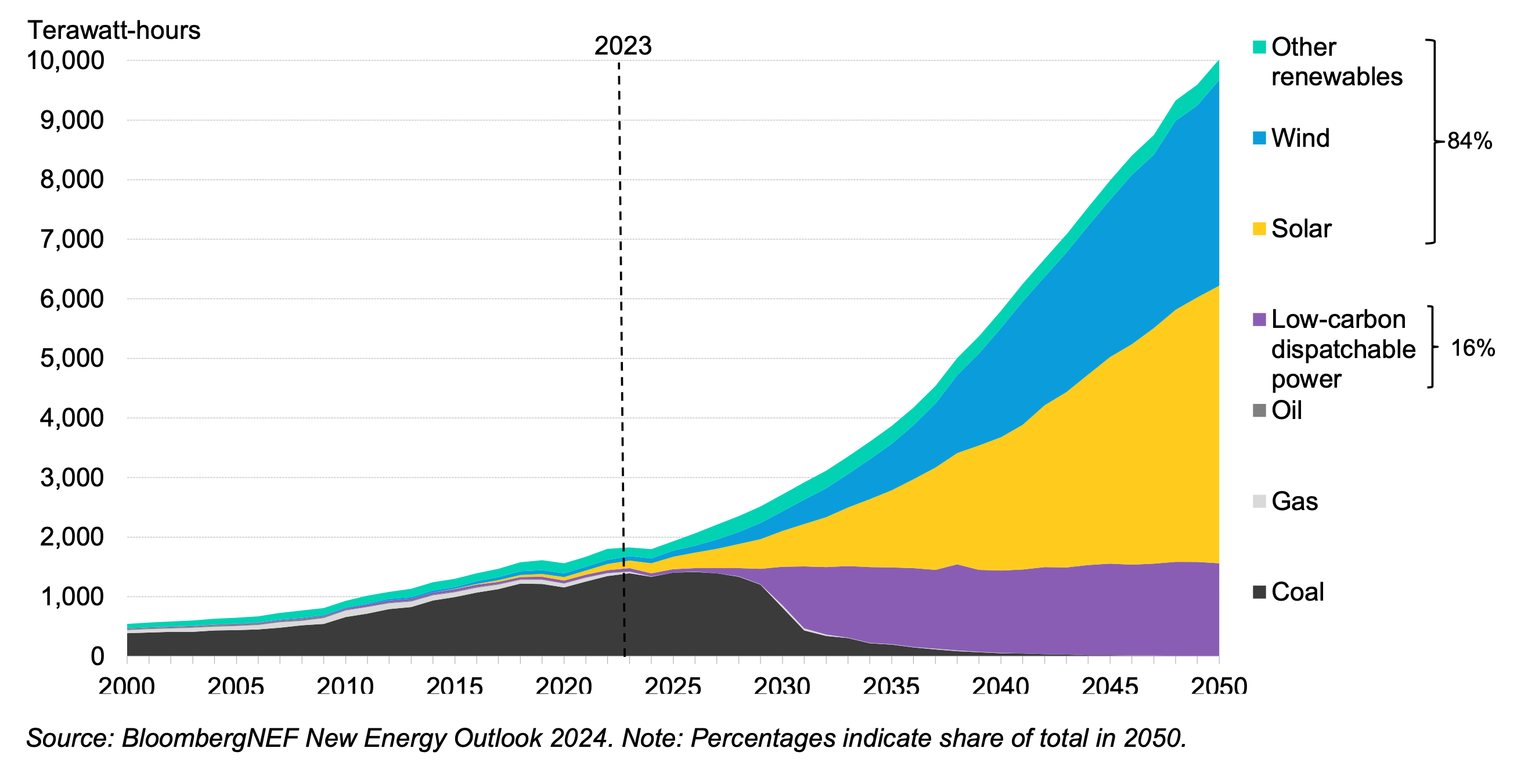
New Energy Outlook
Source: Bloomberg NEF 24/7 Carbon-Free Energy Procurement in APAC: Pathways for Companies and Countries
-> By 2050, India’s power capacity structure can be:
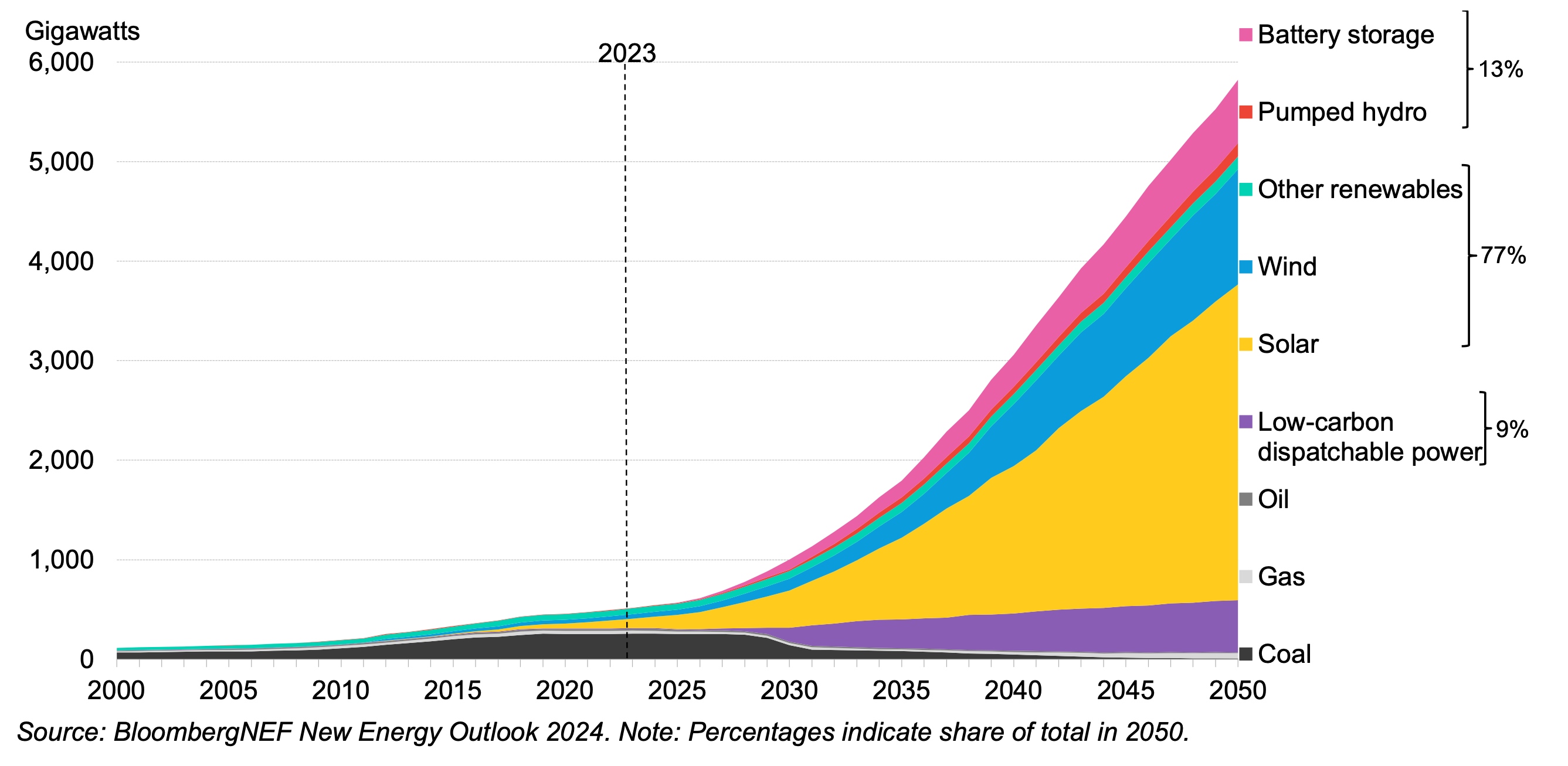
How does RTC Power in renewable energy support India’s 24/7 power ambition?
From 2010 to 2021, India’s greenhouse gas emissions increased by 32.4%. India’s electricity consumption has grown substantially. After an 8.5% drop in 2020, it has rebounded and has grown per year since then. In 2023 alone, consumption surged by 6.7%, reaching 1407 TWh (terawatt-hour).
This recent growth follows a period of rapid expansion between 2010 and 2019, during which electricity consumption increased by 7% annually.
To source this rapid increase in energy consumption sustainably and protect the environment for our future generations, India is focusing on boosting the usage of renewable energy sources.
Let’s explore the data-driven reasons why India’s transition to RTC renewable energy is essential for its energy future.
- Ease of Scheduling of Power
As RE RTC Power systems are firmer and more predictable compared to standalone technologies like solar and wind, their output is easier to predict and schedule as a result. This decreases the challenges for the Load Dispatch Centers.
- Ensuring Grid Stability with Reliable Renewable Energy
Renewable energy sources like solar and wind are variable in their generation patterns. This introduces instability in the grid which can cause difficulties in scheduling of power and useful power getting lapsed. To avoid this and ensure a steady electricity supply, RE can be combined with storage solutions. For example, the Solar Energy Corporation of India’s (SECI) first-ever Round-The-Clock (RTC) tender for 400MW (RTC-1) and the later 5,000 MW RE-plus-thermal (RTC-2) tender demonstrate the shift towards continuous energy availability.
Unlike standalone renewable sources, the RTC energy supply model ensures a stable energy flow with an annual and monthly Capacity Utilisation Factor (CUF) of 70-85%. This is one of the benefits of RTC renewable energy.
- Meeting Renewable Purchase Obligations (RPOs)
By integrating different renewable sources, power distribution companies (DISCOMs) can efficiently meet their RPO targets. According to the Ministry of Power, a minimum portion of electricity consumption must come from renewables, with targets increasing each year until 2029-30. The round-the-clock renewable energy model, with its diverse energy mix, provides a practical way to achieve and even exceed these goals.
- Cost-Effectiveness and Financial Feasibility
The RTC energy model benefits from economies of scale, making it a cost-effective solution in a large capacity case. Investment costs for solar (approximately Rs 4.5 Cr/MW), wind (Rs 6 Cr/MW), and storage technologies are steadily declining, all of which will contribute to lower cost of clean power.
Competitive bidding, as seen in RTC-1 and RTC-2 auctions, has resulted in affordable tariffs of Rs 2.9/kWh and Rs 3.01/kWh, ensuring financial viability.
- Supporting Green Hydrogen Production
RTC power provides a steady energy source for green hydrogen production, which is vital for decarbonisation. With a consistent and renewable power supply, green hydrogen production can expand, helping India meet its climate goals. By using RTC energy, India can reduce greenhouse gas emissions and advance in clean energy development.
What technologies are key to RTC Power?
| Technology |
Description |
| Battery Energy Storage Systems (BESS) |
BESS is an important component of RTC energy solutions which overcome the intermittency of solar and wind energy. It stores the energy during peak generation times and discharges during low generation periods. Thus, it helps in ensuring a consistent power supply. |
| Hybrid Renewable Systems |
By combining multiple sources like solar and wind, hybrid systems take advantage of the different renewable sources. This approach ensures a more consistent power output and makes the RTC energy supply more reliable. |
| Hydropower |
Integrating hydropower with renewables provides a stable source of energy that can be dispatched as needed. |
| Thermal Power Integration |
As a last resort, incorporating thermal power (natural gas or coal) with renewable sources can help maintain a steady electricity supply, especially when renewable generation is low. |
| Smart Grid Technologies |
Advanced grid management systems enhance the integration of variable renewable energy sources and improve demand response capabilities, facilitating RTC power delivery. |
| Demand Response Systems |
These systems adjust consumer demand in real-time based on supply availability to optimise the use of generated renewable energy and ensure a stable electricity flow. |
What are the main challenges in implementing round-the-clock (RTC) renewable energy in India?
Though there are several advantages, these are the main challenges in implementing RTC renewable energy in India:
1. Oversizing of RE sources to get the required CUF
For maintaining a firm source of power using RE, significant oversizing of projects needs to be done to maintain the required Capacity Utilization Factor (CUF) ~ 75%-80%. The prime reason for this is the low CUF for renewable sources like solar (~15%-20%) and wind (~35%-40%). Oversizing for solar is significantly more than wind.
2. Integration of Multiple Generators
Aggregating power from various solar and wind projects across different locations complicates the establishment of long-term Power Purchase Agreements (PPAs) and requires efficient management of transmission access and real-time control systems.
3. Intermittency of Renewable Sources
The variable nature of solar and wind energy leads to inconsistent power generation and makes it difficult to meet continuous electricity demand. This intermittency creates a significant challenge for electricity distribution companies (DISCOMs) that require a stable and reliable power supply. A solution to this problem are the upcoming ESS (Energy Storage System) solutions.
4. Financing Challenges
High upfront costs, technology risks, and longer payback periods associated with energy storage systems make financing RTC energy projects difficult. The cost of energy storage solutions, especially, battery systems can significantly impact the project viability.
Conclusion
India is at a pivotal stage in its journey to becoming a USD 7 trillion economy by 2030. The economic expansion will also increase the energy demand. By 2030, India aims to generate 50% of its electricity from renewable sources and install 500 GW of RE capacity. RE RTC solutions will play a crucial role in India’s green future.
RTC Renewable Energy (RTC-RE) is critical to ensure a reliable power supply, particularly for industries and to support supporting clean energy goals. To facilitate this transition, the government has introduced policies such as renewable-plus-storage tenders and RTC-RE procurement guidelines.
Round-the-clock renewable energy is gaining traction due to its cost-effectiveness and reliability for consumers from the commercial and industrial sectors. The tariff cost for RTC-RE ranges between Rs. 4.0 to Rs. 4.5 per unit which is lower than coal-based energy sources.
The future of RTC renewable energy in India will depend on increased RTC-RE project auctions and government support for Battery Energy Storage Systems (BESS) through viability gap funding (VGF). To attract more investments and ensure a sustainable energy future, India needs to lower storage costs by investing in R&D and new policies.
To conclude, RTC power can be one of the best solutions to the challenges of renewable energy sources. By integrating renewable sources with energy storage, RTC Energy ensures a reliable electricity supply and minimises carbon emissions.
This approach not only meets the increasing energy demands but also aligns with India’s targets of achieving 500 GW of renewable capacity by 2030. Ultimately, the goal is to build a sustainable energy future.
As an Independent Power Producer (IPP), Sunsure enables corporations across India to embrace clean energy through long-term round-the-clock (RTC) Power Purchase Agreements (PPAs) that offset up to 70% of power use to renewable energy through a mix of solar, wind and battery storage technologies while reducing costs by up to 50% compared to conventional sources. The company’s mission is to energise our customers’ sustainability missions.







